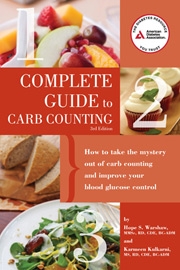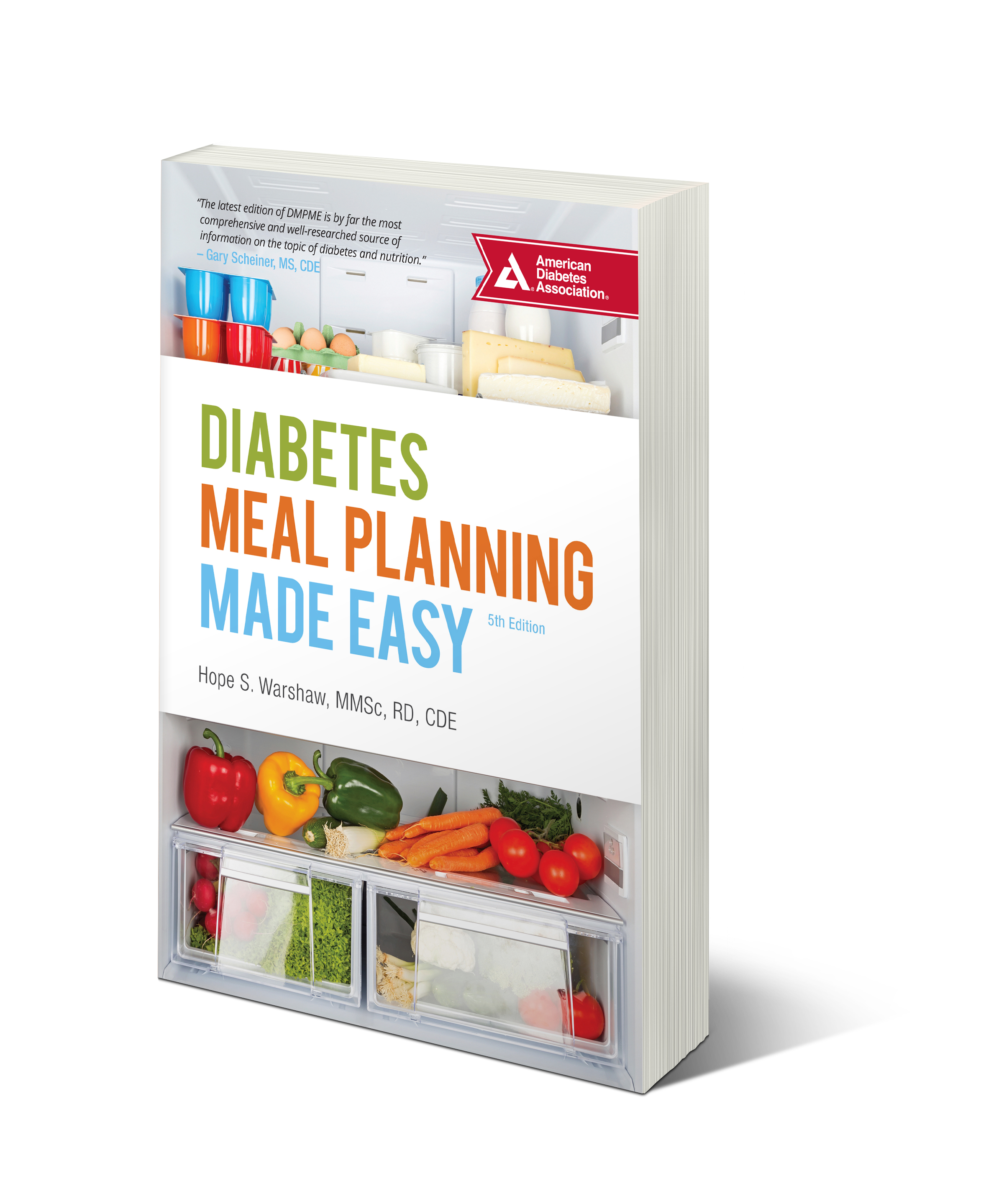Complete Guide to Carb Counting

- baffled by which foods contain carbohydrate and how much?
- confused about how much carbohydrate YOU need to eat each day?
- overwhelmed in the supermarket aisles reading food and nutrition labels?
- inept at where to find carb counts for your favorite foods?
The Complete Guide to Carb Counting, is the American Diabetes Association’s A-Z guide to carbohydrate counting. Carb Counting has quickly become the most popular method of meal planning for diabetes. That’s because research shows it meshes well with real life and the medications available today to manage diabetes. The book begins with answers to two key questions: what is carbohydrate and why should you carb count? Next you'll build your knowledge base about how to count carbs, how much carb to eat, how to use food labels, count carbs in restaurant foods, and much more. This book is right for you if you have type 2 diabetes and use carbohydrate counting to plan choose your foods and plan your meals. The book also has all the details you need if you use carbohydrate counting to determine your meal time insulin doses. Lastly you’ll decipher how to fine-tune your blood glucose levels by observing your blood glucose patterns (aka pattern management).
Reviews
Table of Contents
- What Is Carb Counting?
- Basic Carb Counting
- Keeping Track
- Protein, Fat and Alcohol Count, Too
- Weigh and Measure Foods—A Key to Your Success
- The Food Label Has the Facts
- Carb Counting in Real Life
How to Count Convenience Foods and Recipes - Carb Counting in Real Life
How to Count Restaurant Meals and Take Out Foods - Blood Glucose Pattern Management: Fine-Tune Your Control
- Blood Glucose-Lowering Medications and Insulin
- Advanced Carb Counting
- Cornerstones—Knowledge and Support
- Appendixes
- Carb Counts of Everyday Foods
- Carb Counting Resources
- Record Keeping Forms
Want to Count Carbs More Accurately? Build Your Own Custom Carb Database
For people with type 1 or 2 diabetes carbohydrate, or carb, counting has evolved to be the most common method taught to help you plan meals and, if you take insulin, gauge your insulin doses. Carb counting is based on research showing that it’s the total amount of carbohydrate you eat that most impacts your blood glucose levels after you eat. (Check out two of my articles about the fine art of carbohydrate counting in Diabetic Living magazine Solving
Type 2, Weight Loss and Control – Stop Dreaming, Act NOW
 Do you (or a loved one) have type 2 diabetes and you’re under the impression that your blood glucose would rapidly fall into control if only you could just lose weight? Have you heard this promise from your healthcare provider (HCP)?
Do you (or a loved one) have type 2 diabetes and you’re under the impression that your blood glucose would rapidly fall into control if only you could just lose weight? Have you heard this promise from your healthcare provider (HCP)?
As a dietitian and diabetes educator nothing would please me more than to be able to say this is true. But it’s often not the case and particularly so as type 2 progresses over the years. My message to you, stop dreaming and act NOW!
The main mantra to people with type 2 diabetes, especially early on, used to be lose weight. Though losing 10 to 20 pounds can, especially early on after diagnosis, cause blood glucose to plummet and other medical problem to improve, research shows the continually pounding about weight loss that people often get from their health care provider needs to change. We know much more now about the progression of type 2.
A1C Measure Replaces Glucose to Diagnose Diabetes and High Risk
For years the way to diagnose diabetes has been to draw a blood sample and check the glucose count, either fasting or random (any time of day). Two high levels on two different days and the diagnosis of diabetes was made. Glucose tolerance tests went by the wayside years ago other than for diagnosing gestational diabetes.
Carbohydrate: How Much (or Not) to Munch? Dualing Dialog with Tenderich's diabetesmine.com
Warshaw dialogs with diabetesmine.com blogger Tenderich on her blog about research and recommendations about carbohydrate intake for type 1. Check it out, then read my rebuttal below. Thanks Amy for being open to dialog!
Diabetes Meal Planning Made Easy

- confused about whether you need to limit the amount of carbohydrate you eat?
- baffled by what’s more important: controlling glucose, blood pressure or heart health?
- frustrated trying to lose weightl, keep pounds off and manage diabetes?
- overwhelmed by food labels, nutrition facts and ingredients lists?
Diabetes Meal Planning Made Easy, now in its 5th edition, is thorough, yet practical and realistic in its approach. This perennial best-seller, published by the American Diabetes Association, has become the go-to resource on why, what and how much to eat for people with prediabetes or type 2 diabetes. Readers find cut-to-the-chase advice in three easy-to-digest sections. Section one is: Nutrition and Health Eating Basics. Section two is: Foods by Group, in-depth detail about each food group including alcoholic and non-alcoholic beverages, sweets and desserts and convenience foods. Section three is: Putting Healthy Eating for Diabetes Control into Action, covering how to preplan, supermarket shop, read food and nutrition labels, eat healthier restaurant meals and much more. This action oriented book helps readers slowly but surely change their food choices and eating behaviors for good.
Reviews
Table of Contents
Dedication
Introduction to 5th Edition
Section 1: Diabetes, Nutrition, and Healthy Eating Basics
- Chapter 1: About Type 2 Diabetes and Prediabetes and Why They Happen
- Chapter 2: How to Eat Healthy with Diabetes
- Chapter 3: About Calories, Carbohydrate, Protein, and Fat
- Chapter 4: Sodium, Potassium, and Blood Pressure Control
- Chapter 5: Vitamins, Minerals, and Dietary Supplements
- Chapter 6: Personalize Your Healthy Eating Plan
- Chapter 7: Secrets of Losing Weight and Keeping Pounds Off for Good
Section 2: Foods by Group
- Chapter 8: Starches
- Chapter 9: Vegetables (Non Starchy)
- Chapter 10: Fruits
- Chapter 11: Milks and Yogurts
- Chapter 12: Protein Foods
- Chapter 13: Fats and Oils
- Chapter 14: Sweets, Desserts, and Other Sugary Foods
- Chapter 15: Beverages: Nonalcoholic
- Chapter 16: Beverages: Alcoholic
- Chapter 17: Combination, Convenience, and Free Foods
Section 3: Putting Healthy Eating for Diabetes Control into Action
- Chapter 18: Change Your Food Choices and Eating Behaviors Slowly
- Chapter 19: Planning: A BIG Key to Healthy Eating
- Chapter 20: Control Your Portions
- Chapter 21: Lean on the Food Label and Nutrition Facts
- Chapter 22: Skills and Strategies for Healthy Restaurant Eating
- Chapter 23: Get the Support You Need Up Close or Virtual
Index


